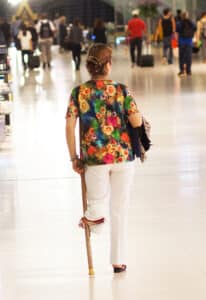People With Limb Loss and Limb Difference Deserve Better Airport Security Screening
By Ryan Geddie, Government Relations Specialist

Photography by Ray Alvarez Model: Xoe Xapoian
Flying should be exciting but, for many people with disabilities, the experience is often less than positive. I asked members of the AC Connect Advocacy community to share their stories about one part of the airport experience that perennially frustrates, confuses and embarrasses people with disabilities: Transportation Security Administration security checkpoints.
One common complaint throughout the responses given by AC Connect members was that there is essentially no common experience between airports.
 Molly McHugh Branyan, a person who has limb loss, said, “It amazes me that the agents are not trained the same. It’s time-consuming, frustrating and at times embarrassing.”
Molly McHugh Branyan, a person who has limb loss, said, “It amazes me that the agents are not trained the same. It’s time-consuming, frustrating and at times embarrassing.”
James Kober, who is an upper limb amputee, said, “No two airports have the same procedure for screening my prosthetic [device]” and that “screening procedures are rarely the same, even at the same airport.”
When screening procedures vary so dramatically across airports, or even within the same airport, it creates an environment of uncertainty for people with limb loss and limb difference when they are flying. This, of course, has an emotional impact, but a lack of consistency also makes it more difficult than necessary for people with disabilities to plan their trips to the airport. One factor that contributes to confusion at security checkpoints appears to be a failure on the part of the TSA to ensure screeners are trained in how to handle prosthetic devices.
 Erin Day let us know that she filed a complaint with the TSA in 2022 after being required to enter a private screening room, unzip her pants and have her bare hip swabbed. After filing a complaint, she said, the “disability section of TSA opened an investigation, confirmed that this was not standard protocol, and identified the TSA agents who had told me otherwise. Unfortunately, the next time I flew out of this same airport, they again requested that I go to a private room so that they could swab my bare hip.”
Erin Day let us know that she filed a complaint with the TSA in 2022 after being required to enter a private screening room, unzip her pants and have her bare hip swabbed. After filing a complaint, she said, the “disability section of TSA opened an investigation, confirmed that this was not standard protocol, and identified the TSA agents who had told me otherwise. Unfortunately, the next time I flew out of this same airport, they again requested that I go to a private room so that they could swab my bare hip.”
This time, Erin avoided this invasive and irregular screening but only after mentioning that she had previously filed a formal complaint.
When screeners don’t follow policy, and force people with limb loss and/or limb difference to undergo embarrassing and invasive screening, our rights, and dignity as people with disabilities have been violated.
In the short term and, taken individually, these incidents might seem minor. After all, the job of the TSA is to make traveling safe, not maximally comfortable.
However, I believe it is in the best interest of safety for the TSA to ensure its policies are enforced with respect and consistency. When I am required to receive a full pat-down, conducted by multiple TSA employees one day, have my hands and prosthetic leg swabbed for explosive residue another day and, on occasion, am waved through security altogether, it makes me question whether TSA screening procedures are really designed to make us safe or just to feel safe.
Inconsistent enforcement even within the same airport and a lack of clarity on the necessity of individual screening procedures damage the reputation of the TSA among people with limb loss and limb difference. Members of our community deserve clarity about why screenings vary so wildly across the TSA, not just because we are individuals who deserve to be treated with respect but because anything less violates the TSA’s own core values of integrity, respect, and commitment.
To participate in discussions like these and share your
experiences, join AC Connect (amputee-coalition.org/acconnect)
and our active Advocacy Community.

